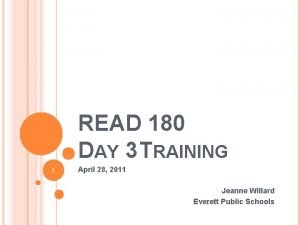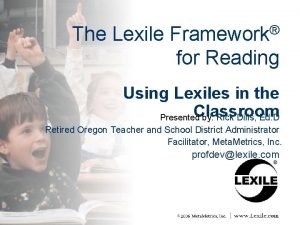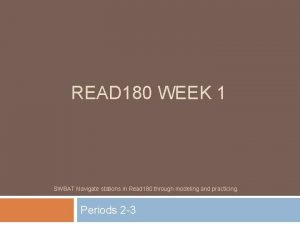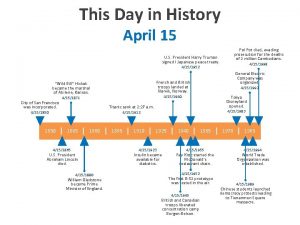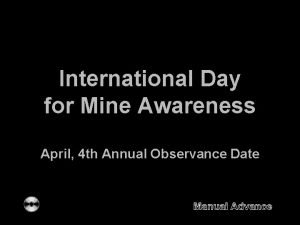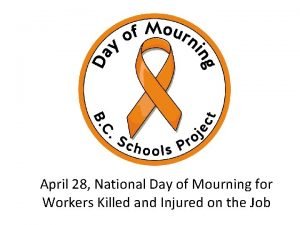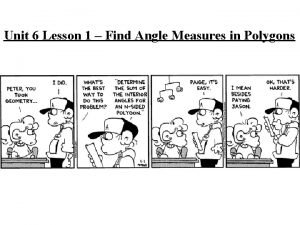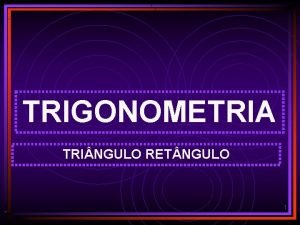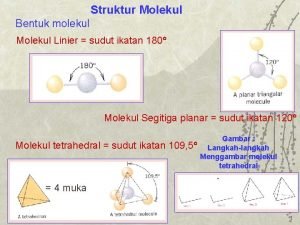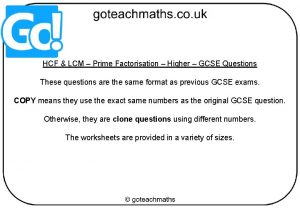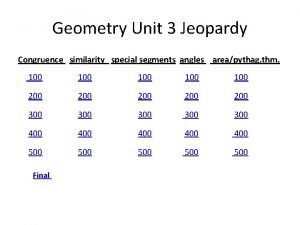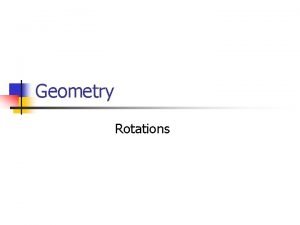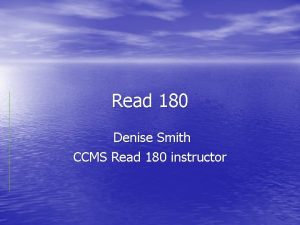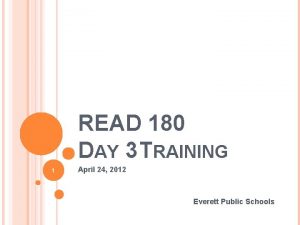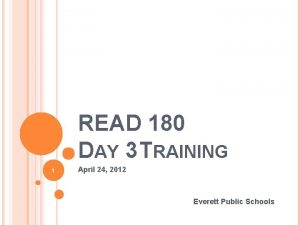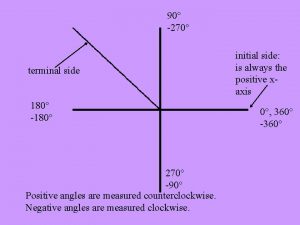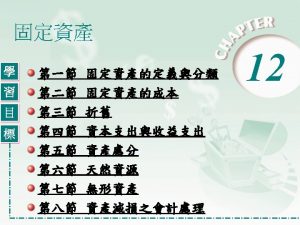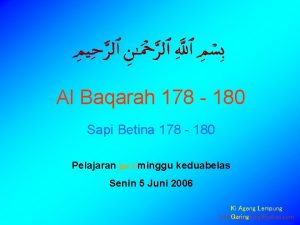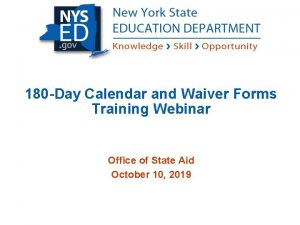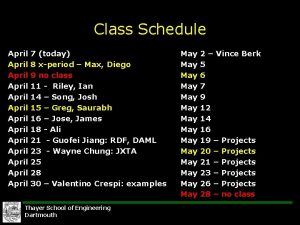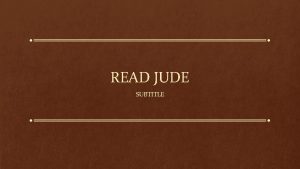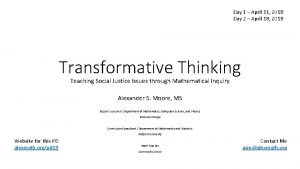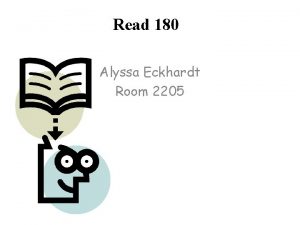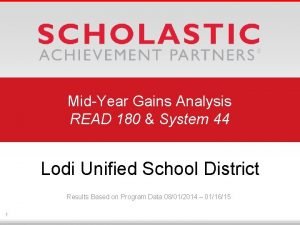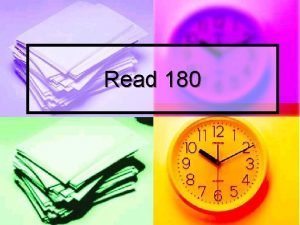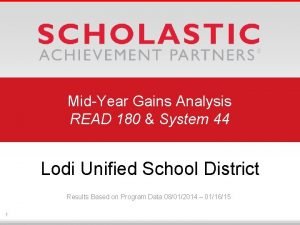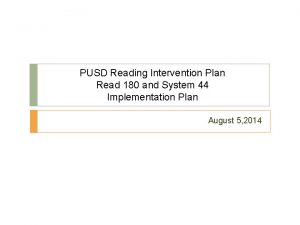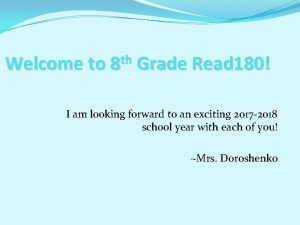READ 180 DAY 3 TRAINING 1 April 28














































- Slides: 46

READ 180 DAY 3 TRAINING 1 April 28, 2011 Jeanne Willard Everett Public Schools

WELCOME READ 180 Mix and Mingle Bingo Get up and move around the room! Find a buddy who fits the description in a box. Have your buddy initial the box. Move on to another buddy. . . Competitive? How many buddies can you get to initial your Bingo card in 15 minutes? 2

OBJECTIVES Re-connect Review Reflect 3

AGENDA Morning Afternoon EPS READ 180 Overview ITS, DTZ – huh? First Three Weeks Using Multiple Measures Deep Dive into the r. Book & Red Routines Headphones & All Things Technical Summarizing and the Explicit Teaching Model READ 180 PLC READ 180 Surveys Evaluation 4

EPS READ 180 OVERVIEW 5

“SNAPSHOT” OF EPS READ 180 • Nearly 900 students • 60% Male • 25% Hispanic • Students in grades 6 -12 • 70% Middle School • 30% High School Special ELL, 10% General Education, 45% Education, schools 45% (34) • Teachers at nine • 8 Reading Support • 22 Special Education • 3 ELL 6

SURVEY FINDINGS Years Teaching READ 180 Years Teaching 7

SURVEY FINDINGS Multiple Preps Reading Endorsement 8

EPS READ 180 ROTATION MODEL 20 minutes* Instructional Software Whole-Group Instruction 5 minutes* *Students complete two Small. Group rotations every day along with either Whole-Group Instruction or Whole-Group Wrap. Up. Small-Group Instruction 20 minutes* Modeled and Independent Reading 20 minutes* Whole-Group Wrap-Up 5 minutes* 9

EPS ROTATIONAL MODEL Blue Group A=Independent Reading B=Small Group C=Instructional Software 10

RBOOK SCOPE AND SEQUENCE High School Middle School Stage B & Flex r. Books 6 th Grade 7 th Grade 8 th Grade As needed Stage B r. Book Workshops 1 -4 Stage B r. Book Workshops 5 -9 r. Book Flex Workshops 1 -4 r. Book Flex Workshops 5 -9 First Year Students Second Year Students Third Year Students As needed Stage C & Flex II r. Books Stage C r. Book Workshops 1 -4 Stage C r. Book Workshops 5 -9 r. Book Flex II Workshops 1 -4 r. Book Flex II Workshops 5 -9 11

SRI ASSESSMENT WINDOWS Last SRI assessment window is May 31 st – June 10 th Four SRI assessment windows per year: Beginning of school year (end of September) 2. November 3. March 4. June 1. 12

READ 180 Evidence of Impact (Students with Baseline & EOY SRI/Lexile Scores 2007 -08) Scholastic Reading Inventory (SRI) Baseline and End-of-Year Data Middle Schools (5 Schools) High Schools (4 Schools) Baseline End of Year READ 180 Average Gap between Reading Level and Grade Level -4. 3 -3. 4 -6. 7 -5. 7 READ 180 Median Gap between Reading Level and Grade Level -5 -4 -7 -6 READ 180 Average Lexile Score 461. 8 574. 8 464 569. 6 READ 180 Median Lexile Score 483 632. 5 502 610. 5 1 3

READ 180 Software Usage and SRI Comparisons (Students with Baseline & EOY SRI/Lexile Scores 2007 -08) READ 180 Segments Completed Average Lexile Growth Average Growth in Reading Levels (Based on Lexile Scores) 0 -10 (n = 287) 11 - 20 (n = 112) 21 - 30 (n = 30) 31 - 40 (n = 11) 41 - 50 (n = 4) 101. 2 138. 7 106. 5 38. 7 111. 2 0. 9 0. 53 0. 27 0. 9 0 - 500 (n = 192) 501 -1000 (n = 159) 1001 - 1500 (n = 61) 1501 - 2000 (n = 20) 2001 - 3000 (n = 5) Average Lexile Growth 101 125. 4 131 59. 9 -11 -150 Average Growth in Reading Levels (Based on Lexile Scores) 0. 8 1 0. 92 0. 38 0 -1 READ 180 Total Minutes 3000+ (n = 1) 14

Demographic Comparisons (Students with Baseline & EOY SRI/Lexile Scores 2007 -08) Gender Average Lexile Growth Average Growth in Reading Levels (Based on Lexile Scores) Meal Status Average Lexile Growth Average Growth in Reading Levels (Based on Lexile Scores) Ethnicity Males (n=262) Females (n=182) 112. 8 108. 9 0. 9 Yes No (n=291) (n=153) 95 142 0. 75 1. 2 Asian (n=53) Black (n=38) Hispanic (n=96) White (n=233) Other (n=22) Average Lexile Growth 99. 5 61 87. 9 123. 9 189. 3 Average Growth in Reading Levels (Based on Lexile Scores) 0. 71 0. 47 0. 67 1 1. 4 15

Years of Teaching Compared to SRI Growth (Students with Baseline & EOY SRI/Lexile Scores 2007 -08) Number of Years Teaching 1 Year Or Less (n=90) 2 - 5 Years 6 -10 Years (n=59) (n=46) 11 -20 Years (n=13 20+ Years (n=59) Average Lexile Growth 54. 7 120. 1 108 139. 9 94. 6 Average Growth in Reading Levels (Based on Lexile Scores) 0. 6 0. 9 0. 7 1. 2 0. 7 Number of Years Teaching READ 180 Average Lexile Growth Average Growth in Reading Levels (Based on Lexile Scores) 1 Year or Less (n=370) 2 Years (n=37) 3+ Years (n=37) 107. 8 134. 5 121. 8 0. 9 1 1 16

ITS, DTZ – HUH ? 17

INTERACTIVE TEACHING SYSTEM (ITS) http: //education. scholastic. com/its/r 180 The READ 180 Teacher Shared Space is a great resource too! 18

DIGITAL TRAINING ZONE (DTZ) http: //teacher. scholastic. com/products/edserv icesondemand/digitaltrainingzone. asp 19

FIRST THREE WEEKS 20

FIRST THREE WEEKS Why wait to start? Why start with the First Three Weeks? Supplementing the First Three Weeks � Deeper Look at Writing “I supplement the First Three Weeks by ______________” 21

LAST THREE WEEKS Possibilities. . . ? 22

USING MULTIPLE MEASURES 23

USING MULTIPLE MEASURES Entrance and Exit Criteria Lexile scores SAM Reports Grading Practices 24

ENTRANCE &EXIT CRITERIA 25

LEXILE SCORES & GRADE LEVELS Grade At Risk Basic Proficient Advanced 1 N/A BR=99 - 100 -400 401+ 2 99 - 100 -299 300 -600 601+ 3 249 - 250 -499 500 -800 801+ 4 349 - 350 -599 600 -900 901+ 5 449 - 450 -699 700 -1000 1001+ 6 499 - 500 -849 800 -1050 1051+ 7 549 - 550 -849 850 -1100 1101+ 8 599 - 600 -899 900 -1150 1151+ 9 649 - 650 -999 1000 -1200 1201+ 10 699 - 750 -1024 1025 -1250 1251+ 11 799 - 800 -1049 1050 -1300 1301+ 26

ON-THE JOB LEXILE REQUIREMENTS NATIONAL ADULT LITERACY STUDY Joyce and Showers (1996) Student Achievement Through Staff Development 27

SAM REPORTS READ 180 Reading Progress Report � Reading Counts Reading Progress Report � Are there usage patterns and correlations between time and performance data? Are there incentives or ways to help students monitor their progress based on this report? Is there a need for reading groups based on this report? SRI Growth Report � Are students making significant growth in the program? What interventions or support are needed for students? What incentives and motivation is needed? • Take a look at your reports. • Work with your group to unpack these questions. • What questions do you have? If time allows: In your group, share out your grading practices. . . 28

FORTUNE COOKIE SHARE-OUT 1. 2. 3. 4. Open your fortune cookie; open it but don’t read the “fortune” out loud or share it with anyone else. Think how this “fortune” may relate to you, your READ 180 work and the data we just looked at. Jot down notes if you wish as you will be asked to share this. “Go round” one at a time and read your “fortunes. ” Describe how it relates to your READ 180 work. What are your next steps after looking at the data? Eat the fortune cookie! Adapted from www. nsrfharmony. org, Dave Lehman, April 28, 2005 29

DEEP DIVE INTO THE RBOOK &RED ROUTINES 30

RBOOK: WORKBOOK + PLANNER 31

EXPLICIT INSTRUCTIONAL MODEL & THE RED ROUTINES Five Red Routines for reading 1. 2. 3. 4. 5. Teaching Vocabulary Oral Cloze T-W-P-S Idea Wave Numbered Heads Two Red Routines for writing The Writing Process 2. Peer Feedback 1. Three r. Book readings 1. I do 2. We do 3. You do 32

WHY NONFICTION? Numbered Heads � Count off 1, 2, 3, 4 Go to your new group: 1. 2. 3. 4. A Literacy Necessity, A Place for Nonfiction Reading Interests, How Many Books? , How Can Teachers Obtain Books For Classroom Library Collections? What Kinds of Information Books Should I Include? Effective Library Areas, The Role of Teacher, Conclusion Read/skim the sections from the reading assigned to your group. Discuss with your group: • What ideas stood out from the section(s) you read? • What impact does this have on my students? 33

HEADPHONES &ALL THINGS TECHNICAL 34 with the wonderful Terie Messick

HEADPHONES & ALL THINGS TECHNICAL Headphone troubleshooting Purchasing headphones Other computer issues Adding and deleting students Software problems “The Help Desk and/or the Techs helped me with READ 180 when _______________” 35

WHAT IS FASTT MATH? 36

SUMMARIZING & THE EXPLICIT TEACHING MODEL 37 with the fabulous Cindy Foster

READ 180 PLCS 38 with the lovely Carmen Boggs

READ 180 SURVEYS 39

READ 180 TEACHER SURVEY HIGHLIGHTS – WHAT DO YOU VALUE MOST ABOUT READ 180? Everything - I believe this program works and creates independent readers. Great program and it really helps students to learn to read. I like that the program is easy to use (well planned and easy to follow) and that my students seem to like the topics that are presented. Read 180 Software The focused instruction The computer program How structured the program is, and the ease of implementation. Time in small group to work with students and give immediate feedback. I value the balance between pleasure reading and academic reading. I value the individualize instruction. It is a diverse program, offering multiple strategies and materials. It has helped my students feel successful. The rbooks and teacher book. the ability to see the individual student's needs Instructional strategies All of it! I only wish it was all I taught and that I coaudl do the 90 minute model. I LOVE READ 180! The balanced approach with reading and writing as well as other skills connected in the language arts program. The consistency and multi-targeted approach in the r. Book I like the idea of helping struggling readers. The is a great variety of reading materials for students to choose from. Small group interaction with students I especially value the softcover books. The gains my students are making in reading Richness of materials, flexibility. 40

READ 180 TEACHER SURVEY HIGHLIGHTS – WHAT MOTIVATES STUDENTS? They work at their own level of excellence. An increase in their Lexile scores is one form of motivation for my students. Also, they feel successful because they receive immediate feedback from the computer program. The different types of books available at their reading level. Feeling successful in school. The bond we have as a class, the computer program and the books to read. Reading books that are interesting, and writing on the Moodle. Frequent experiences of success Success. . . reading a book they CAN read, at passing the quizzes and the looks on their faces when they see how much they have gone up on their Lexile score. . . PRICELESS!!!! Audiobooks and computers The students feel that the program is teaching them in a cool way. The interesting content of materials, frequent feedback about progress Teacher enthusiasm and knowledge of materials; goal setting and personal attention; Immediate feedback. Positive feedback Books that interest them Seeing their own achievement Completing a section Immediate feedback, goal setting, and encouragement from educators. Improving their SRI score motivates my students. The anchor videos and whole group discussions seem the most motivational aspects. The climate that I've built in class. . . this is not a "dumb" reading class Being able to improve reading scores and exiting from the program after enough growth on classroom, district and state assessment improvements are shown. They find the topics and activities in the R book very interesting and LOVE the positive feedback they receive when using the computer. No idea. My students are rarely motivated. Success seems to be a wonderful motivator. When students see themselves making progress on their SRI scores, their reading counts quizzes or software activities, they are inspired to continue working and trying harder. 41

READ 180 STUDENT SURVEY Think Skim the Student Information Surveys � What question(s) do you have for READ 180 students? � Write � Pair � On an index card, write a question you would like to ask READ 180 students. Share and discuss the questions you wrote on the index card. One question I have for my READ 180 students is “__________________ _? ” Share � Using the sentence starter, share a question you would like to ask READ 180 students with the group: 42

TELL THE STORY OF A READ 180 STUDENT. . . Skim through our list of what motivates READ 180 students. (Writing Process: Generate Ideas) Choose an idea or two from the list and imagine a student or group of students this idea describes. (Writing Process: Plan) Tell the story of this student and describe how this student is or has become motivated. . . (Writing Process: Write) We’ll skip over Revision and Editing. Share your story with a partner. Process: Final Draft/Present) (Writing 43

READ 180 CONTEST Statements describing how READ 180 has helped to make a difference in your school or classroom. Prizes are books. Information available on READ 180 website. 44

EVALUATIONS 45 Thank you for a wonderful day together!

“I USED TO THINK. . . AND NOW I THINK. . . ” I Used to Think. . . And Now I Think. . . Adapted from “I Used to Think…and Now I Think…” by Richard F. Elmore 46
 Day 1 day 2 day 3 day 4
Day 1 day 2 day 3 day 4 Read 180 lexile chart
Read 180 lexile chart Day 1 day 2 day 817
Day 1 day 2 day 817 Lexile measure
Lexile measure Read 180 stations
Read 180 stations Astronomy picture of the day 17 april 2001
Astronomy picture of the day 17 april 2001 Kenn nesbitt poems
Kenn nesbitt poems 20th april 1889
20th april 1889 This day in history april 15
This day in history april 15 National sovereignty and childrens day
National sovereignty and childrens day Portugal april fools day
Portugal april fools day International day april 4
International day april 4 April 28 day of mourning
April 28 day of mourning Family portal schoolmax
Family portal schoolmax Oceans apart day after
Oceans apart day after Day to day maintenance
Day to day maintenance As your room gets messier day by day, entropy is
As your room gets messier day by day, entropy is I don't know about tomorrow i just live from day to day
I don't know about tomorrow i just live from day to day Romeo and juliet act 2 timeline
Romeo and juliet act 2 timeline Growing day by day
Growing day by day Seed germination inhibitors examples
Seed germination inhibitors examples Seed germination conclusion
Seed germination conclusion Observation of plant growth day by day
Observation of plant growth day by day I live for jesus day after day
I live for jesus day after day Oh glorious day
Oh glorious day Day one day one noodle ss2
Day one day one noodle ss2 Dayone dayone noodles ss2
Dayone dayone noodles ss2 Training is expensive without training it is more expensive
Training is expensive without training it is more expensive Metode of the job training
Metode of the job training Aggression replacement training facilitator training
Aggression replacement training facilitator training 300 ün 25 i kaçtır
300 ün 25 i kaçtır Brain arcade math 180
Brain arcade math 180 (n-2)180
(n-2)180 Sen (a-b)
Sen (a-b) Gmt and idl
Gmt and idl Teorema fundamental de la trigonometria
Teorema fundamental de la trigonometria Sudut molekul
Sudut molekul Ioanna papatsouma
Ioanna papatsouma Poludníky a rovnobežky
Poludníky a rovnobežky 180 degree axis rule
180 degree axis rule Longitude lines give directions and of the prime meridian
Longitude lines give directions and of the prime meridian Lygus kampai
Lygus kampai Art 187 lgt
Art 187 lgt Gcse hcf and lcm questions
Gcse hcf and lcm questions Kristen enriquez
Kristen enriquez 180-75
180-75 180 roation
180 roation

